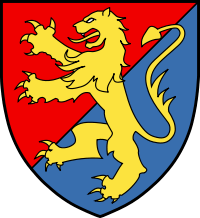Torkel Knutsson

Torkel (Tyrgils or Torgils) Knutsson, known well as Marshal Torkel, (?–1306) of Aranäs, was constable, privy council (riksråd), and virtual ruler of Sweden during the early reign of King Birger Magnusson (1280–1321).
When Tavastland was attacked by the Republic of Novgorod in 1292, marshal Torkel led the third Swedish crusade against Novgorod.
Biography

Torkel hailed from an old noble family of West Geatish ancestry and was related to the Folkungs, the royal family, and like them, he had a lion in his coat of arms. He was first mentioned in 1282. In documents from 1288, he is mentioned as a knight and a member of the privy council (riksråd).
Family
Torkel was married twice. His first wife, whose origins are unknown, gave him a daughter named Kristina, who married Torkel's godson and later enemy duke Valdemar. She appears to have been repudiated by the duke upon her father's execution (as Valdemar is soon reported to have married with Ingeborg Eriksdottir of Norway). Torkel's second wife was the countess Hedvig of Ravensberg.
Career
When King Magnus Ladulås died, Torkel became regent for the underage King Birger, being the highest state official and because Magnus' foreign-born widow, Hedwig of Holstein, was not trusted to such powerful position yet.
When Tavastland had been attacked by the Republic of Novgorod, in 1292, marshal Torkel led the third Swedish crusade against Novgorod, in 1293 and conquered parts of Karelia, where he founded the stronghold of Viborg. In 1299-1300, he led an attack against the Novgorodians, and on the Neva River, he founded the fortress of Landskrona
He showed the same concerns about Swedish domestic politics. During his regency, the law of Uppland was established. He acted as Birger Jarl had done in the conflict against the church, in order to abolish the clergy's tax exemption. The clergy's discontent became apparent in 1303.
The old trade treaties with Lübeck were re-established, on condition that the town did not provide Novgorod with weapons or provisions.
In the struggles between king Birger Magnusson and his brothers, the dukes Eric and Valdemar, Torkel was faithfully on the king's side. At Torkel's castle Aranäs, in 1304, the two dukes had to sign a declaration that they would neither in Sweden, nor abroad, work against the king nor cause him harm. In spite of this declaration, the two dukes fled abroad and with the support of the Norwegian king Haakon V of Norway, they attacked Västergötland. Torkel helped the king conquer the castle of Nyköping, which belonged to duke Eric, and in Kolsäter (1305), he forced the two dukes to sign a declaration that they would not cause any harm to Torkel either.
When the power of the dukes was on the rise again, the marshal had to reconcile with the church, and he ordered a charter on the renewal of the church's old rights, in 1305.
However, Torkel was finally struck by the vengeance of his enemies. The dukes managed to win the trust of the king and poisoned the king's mind against his marshal. In December 1305, King Birger and the dukes arrived at Torkel's estate Lena (where formerly the Battle of Lena had taken place) in Västergötland, and arrested Torkel who was taken to Stockholm in chains. In February 1306, the faithful marshal's head was cut off. The dukes were so hateful against Torkel that his body was entered on the place of execution. It was later moved and properly buried at the Franciscan church in Stockholm.
Remembrance
Torkel's powerful personality and tragic end has been the matter of poetry, in e.g. B. v. Beskow's tragedy Torkel Knutsson. A statue of Torkel (by Ville Vallgren) was raised, in 1908, on the square Rådhustorget in Vyborg.
Sources
![]() This article contains content from the Owl Edition of Nordisk familjebok, a Swedish encyclopedia published between 1904 and 1926, now in the public domain.
This article contains content from the Owl Edition of Nordisk familjebok, a Swedish encyclopedia published between 1904 and 1926, now in the public domain.